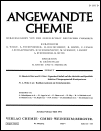The Separation of Zirconium and Hafnium by Liquid-Liquid Partition of their Thiocyanates†‡
Dedicated to Professor W. Klemm on the occasion of his 70th birthday
16th Communication on the separation of inorganic substances by partition between two liquid phases. 15th Communicaton: W. Fischer, K.-J. Bramekamp, M. Klinge, and H.-P. Pohlmann, Z. anorg. Chem. 329, 44 (1964).
Abstract
The partition equilibria of zirconium and hafnium thiocyanates between water and methyl isobutyl ketone have been studied under various conditions. Since the system shows extremely marked deviations from Nernst's distribution law, the two elements cannot be prepared in a very pure state by a simple multi-stage partition. By the use of suitable additives and a new scheme of material flow, however, a continuous process using 23 mixer settlers has been developed, by means of which ZrO2 containing less than 10 p.p.m. of HfO2 and HfO2 containing only 0.3% of ZrO2 can be obtained from a zirconium-hafnium mixture (hafnium content: 1 to 2%).




